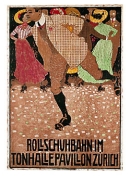The Pioneers of the Swiss Poster
The Golden Age of the Swiss Artist Poster
By 1920, the artists had demonstrated their excellence in all areas of poster advertisement, among them influential landscape painters such as Emil Cardinaux, Karl Bickel, Wilhelm Friedrich Burger, Ernst Schlatter and Otto Baumberger. The expressive power of the poster image was influenced by lithography, which was a suitable printing method for the designs, content and brilliance needed in advertising. The poster designers were supported by several lithographic printing businesses: the Wolfensberger printing company in Zurich, which also owned the Wolfsberg art salon, played a major role in the quality and the success of the early Swiss posters.
By 1910, the idiosyncratic pioneer Burkhard Mangold had designed over 40 posters with a high artistic sensitivity and a colouring style influenced by impressionism in that it used “colourful spots”. His designs are sometimes reminiscent of Degas. In 1920, when he had just completed his 100th poster, Mangold spoke of a certain fatigue that came from designing posters, which he claimed did not require high-quality work but rather constantly new ideas. Hardmeyer set a precedent for humanised animal figures in his poster for Waschanstalt Zürich (Zurich laundry). The brilliant Otto Baumberger was the unsurpassed master of the large, often monumental style of visual expression which employed minimal illustrative techniques and colouring and can be found in many of his numerous poster designs.
The first phase of the Swiss artist poster ended, however, in the doubt whether poster design could really be the task of artists. The substantial amount of designs by artists such as Burkhard Mangold, Emil Cardinaux and Otto Baumberger shows clearly that constantly coming up with new poster ideas did not promote the development of a personal style but rather the routine combination of creative techniques and motives.
As a result, during the twenties and thirties, poster design was increasingly taken over by graphic designers. However, during these decades there was not yet a clear boundary between the artist poster and the graphic design poster. Graphic designers may have had better knowledge of typography, but they, too, understood poster design as a mainly artistic task. Direct advertising through immediate depiction of the product, however, was invented by a painter, namely Otto Baumberger. His 1923 design for PKZ with the coat is possibly the most impressive object poster ever created.

